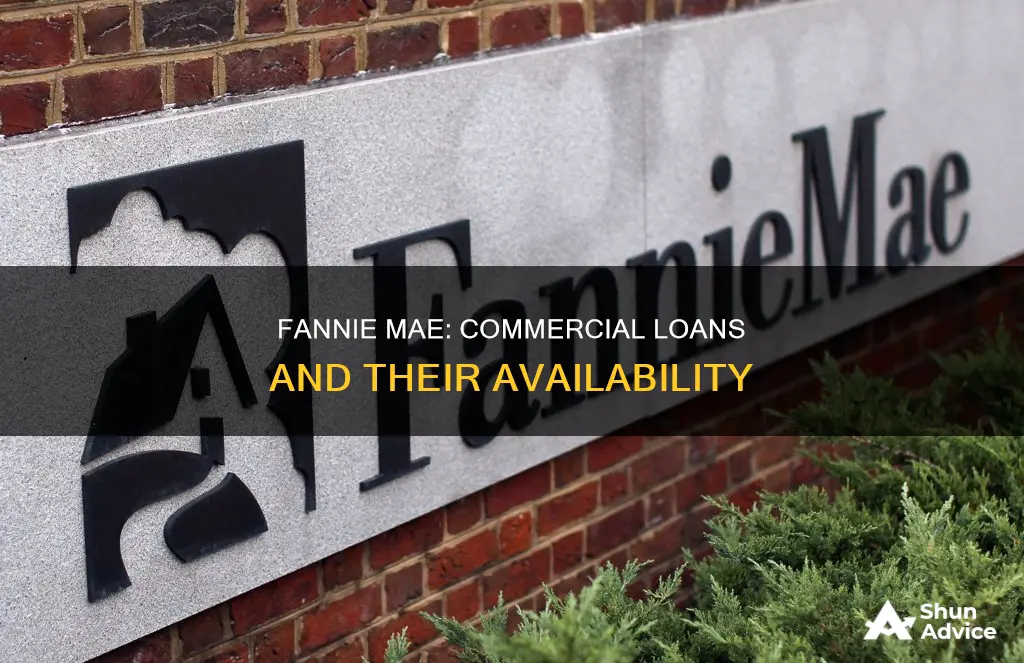
Fannie Mae is a US government-sponsored enterprise that focuses on expanding housing opportunities across the country. While it does not offer direct commercial real estate loans, investors can rent a certain amount of commercial space if they use an FNMA loan to purchase a multifamily property. For example, apartments purchased with a Fannie Mae DUS loan are permitted to have up to 35% of their property's space occupied by commercial tenants, or they can derive 20% of the property's income from commercial sources. Fannie Mae Multifamily has been a reliable source of mortgage capital for the secondary mortgage market for over 35 years.
| Characteristics | Values |
|---|---|
| Commercial Real Estate Loans | Does not offer direct loans |
| Commercial Space Limits | Up to 35% of the rentable area |
| Commercial Space Income | Up to 20% of the property's income |
| Loan Amount | $1 million to $100 million |
| Interest Options | Fixed and adjustable rates available |
| Rate Locks | 30- to 180-day rate locks |
| Assumable | Yes, with lender approval and a 1% fee |
| ARM 7-6 LTV Allowance | 80% |
| ARM 7-6 Fixed-Rate Conversion | 10/9.5 or 7/6.5 fixed yield maintenance loan |
| Credit Score | 680 or higher |
| Net Worth | Equal to or exceeding the loan amount |
| Liquidity | 9 to 12 months of debt service |
| Documentation | 12-month operating statement, current rent roll, occupancy reports, property photos, personal financial statement |
What You'll Learn

Fannie Mae does not offer direct commercial real estate loans
While Fannie Mae does not offer direct commercial real estate loans, it does provide a range of options for apartment and multifamily financing. These loans are non-recourse, structured with a fixed rate over a 30-year term, and allow for 80% leverage. Fannie Mae's Delegated Underwriting and Servicing (DUS) model is the premier financing platform in the multifamily market, making workforce rental housing possible in every market.
Fannie Mae's DUS loans are available for multifamily properties with a large concentration of student or military tenants (up to 80% allowed). However, projects with military or student tenant concentrations above 80% are required to use Fannie Mae's military or student housing programs. The DUS program allows for loans of $3 million or above.
Fannie Mae also offers multifamily small loans, which are sized between $750,000 and $5 million. These loans offer streamlined underwriting and documentation requirements and are perfect for borrowers looking for smaller multifamily loans with faster processing.
Additionally, Fannie Mae provides affordable housing loans with a minimum loan size of $1 million. This program is designed for properties using the Section 8 Housing Assistance Program (HAP), projects with expiring LIHTC tax credits, or other specific affordable housing arrangements.
Investors can rent a certain amount of commercial space if they use an FNMA loan to purchase a multifamily property. For example, apartments purchased with a Fannie Mae DUS loan can have up to 35% of their property's space occupied by commercial tenants or derive 20% of the property's income from commercial sources, whichever is less.
Fannie Mae is committed to affordable housing and wants to be a part of the preservation, rehabilitation, and new construction of quality rental housing across the United States.
Fannie Mae's Rehab Loan Options: What You Need to Know
You may want to see also

Investors can rent a certain amount of commercial space
While Fannie Mae does not offer direct commercial real estate loans, investors can rent a certain amount of commercial space if they use an FNMA loan to purchase a multifamily property.
Fannie Mae is a US government-sponsored enterprise that focuses on expanding housing opportunities across the US. It does this by purchasing residential mortgages from lenders and securitizing them into mortgage-backed securities. Fannie Mae is one of the largest sources of apartment loans in the US, providing non-recourse multifamily financing in amounts between $1 million and $100 million.
Fannie Mae's Delegated Underwriting and Servicing (DUS) model is the premier financing platform in the multifamily market. It allows for up to 35% of the rentable area to be used for commercial property, which can contribute a maximum of 20% of a project's effective gross income. This means that investors can rent up to 35% of the net rentable area of a multifamily property purchased with a Fannie Mae DUS loan to commercial tenants, as long as the rental income from these tenants does not exceed 20% of the property's total income.
This commercial space limit is also applicable to the Fannie Mae Small Loans program, which offers multifamily loans between $750,000 and $5 million with streamlined underwriting and documentation requirements.
By renting a portion of their multifamily property to commercial tenants, investors can benefit from additional rental income. This can be especially advantageous if the commercial tenant is experiencing rapid growth, as the landlord can then claim a share of the tenant's sales once a certain threshold is reached, known as a breakpoint. This concept, known as percentage rent, is commonly included in retail leases, especially for larger tenants.
Who Owns My Mortgage Loan? Fannie, Freddie, and You
You may want to see also

Commercial space must be no more than 35% of the net rentable area
Fannie Mae is a US government-sponsored enterprise that focuses on expanding housing opportunities across the United States. It does not offer direct commercial real estate loans, but investors can rent a certain amount of commercial space if they use an FNMA loan to purchase a multifamily property.
Fannie Mae's DUS loan is the most popular multifamily loan program offered by the company. It allows for loans of $3 million or above. The DUS model is the premier financing platform in the multifamily market, and it makes workforce rental housing possible in every market, every day.
Fannie Mae's DUS loan permits apartments to have up to 35% of their property's space occupied by commercial tenants. This is also called the commercial space limit. This limit is also applicable to the Fannie Mae Small Loans program.
The 35% commercial space limit is calculated based on the rentable area of the property. "Rentable Area" represents the number of square feet based on which office tenants pay annual rent per square foot. Every landlord advertises vacant space based on Rentable Area, but this is only an approximation of the size of the premises. Rentable Square Footage adds in any common areas that all tenants have access to and must therefore maintain.
Fannie Mae also offers the Green Financing program, which permits up to 35% of the rentable area to be used for commercial property.
MPN Student Loans: Who Needs to Fill Them Out?
You may want to see also

Fannie Mae's Multifamily Small Loan Program
Fannie Mae is a US government-sponsored enterprise that focuses on expanding housing opportunities across the United States. While it does not offer direct commercial real estate loans, investors can rent a certain amount of commercial space if they use an FNMA loan to purchase a multifamily property.
FAFSA Loan Awards: What You Need to Know
You may want to see also

Fannie Mae is one of the largest sources of apartment loans in the US
Fannie Mae is a prominent source of capital for apartment loans in the United States. It offers non-recourse multifamily financing ranging from $1 million to $100 million. The organisation provides a range of options for apartment and multifamily financing, each with distinct attributes. These loans are structured with a fixed rate over a 30-year term and allow for 80% leverage.
Fannie Mae's Delegated Underwriting and Servicing (DUS) model is the premier financing platform in the multifamily market. It is the largest guarantor of mortgages in the US and sets the standards for the housing finance market through its underwriting guides, disclosure and asset management tools, data standards, and engagement with lender partners. The DUS model provides liquidity in every market.
Fannie Mae serves a wide spectrum of the market, including conventional, rent-restricted, cooperatives, senior housing, student housing, small balance loans, and manufactured housing communities. Over 90% of the apartments financed by Fannie Mae are "workforce housing", affordable for families earning at or below 120% of the area median income.
Fannie Mae's multifamily loans include the DUS loan program, which is the most popular and allows for loans of $3 million or above. The multifamily small loans program offers loans between $750,000 and $5 million, with streamlined underwriting and documentation requirements. The affordable housing loans program has a minimum loan size of $1 million and is designed for projects using the Section 8 Housing Assistance Program or other specific affordable housing arrangements.
Fannie Mae's multifamily loans have specific prerequisites and requirements, including substantial borrower experience, a net worth equal to or exceeding the loan amount, liquidity, and a credit score of 680 or higher. These loans are only accessible to single-asset US borrowers with proper US ownership.
Factoring: Understanding Loan Factor and Its Impact
You may want to see also
Frequently asked questions
No, Fannie Mae does not offer direct commercial real estate loans. However, investors can rent a certain amount of commercial space if they use an FNMA loan to purchase a multifamily property.
Commercial space must be no more than 35% of the net rentable area and must produce no more than 20% of the property's income.
Borrowers must have substantial industry experience and a net worth equal to or exceeding the loan amount. A credit score of 680 or higher is required, and there must be no recent adverse credit events.







